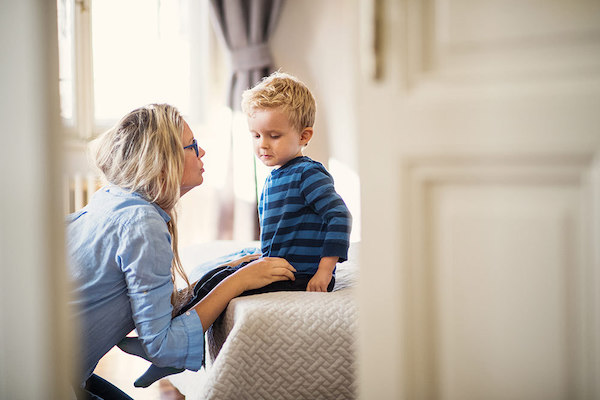A Primer on Gentle Parenting

Why parents are moving toward a more understanding, empathetic, and unified form of raising their children.
Expert Sources: Sarah Ockwell-Smith, Noel McDermott, PT
Millennials have been called one of the more self-aware generations to date. (OK, maybe it was a generalized, self-proclaimed statement, but either way.) Browse any social media platform, and you’ll likely come across a host of accounts, reels, memes, and discussion boards on the importance of being cognizant of our feelings and emotions, our childhood traumas, the state of our mental health, how we process stress, and how these factors affect our relationships with ourselves and others, especially our children.
As feelers, we tend to focus more on the heart of things, which may be why there’s been a rise in popularity around “gentle parenting,” which has become a catchall buzz-phrase for many of the trending attachment-style parenting techniques of today, including modeling emotional regulation and teaching little ones how to express and understand feelings.
But what makes the gentle parenting style unique? And what does it offer families in return? Is shared emotional regulation between parents and their children really the holy grail to peace in the home and in real-life parenthood? Find out for yourself from the pros who preach gentle parenting and claim that it benefits the whole family.
What is Gentle Parenting?
Gentle parenting focuses on four main principles: empathy, respect, understanding, and boundaries.
Empathy
Understand that your child has needs and feelings, and share them together. By being aware of your child’s feelings in moments of conflict, you can better understand the root issue (such as fear or disappointment) and help them put words to their emotions.
Respect
This applies to what you say to your child as well as how you say it. Your child, like any other person, deserves patience, explanation, and kindness in tone. The easiest way to remember this is to communicate to your child in the same way you would like to be spoken to in return.
Understanding
Young children cannot regulate their emotions on their own and require the help of loving adults to learn the skills to self-regulate, which starts at around age 5. Knowing your child’s brain is still developing helps in keeping the perspective that they cannot act the same as adults and shouldn’t be expected to in all situations.
Boundaries
A misconception about the gentle parenting method is that it doesn’t involve rules, but this isn’t the case. Gentle parenting does, however, teach consistency, so stick to age-appropriate boundaries you believe in, and feel comfortable enforcing them on a daily basis.
The gentle parenting approach builds on the method of authoritative parenting and aims to meet children where they are, offering love, patience, kindness, and understanding without shame, guilt, or punishment.
Gentle parenting teaches caregivers to be aware of their child’s developmental stage and to remove their personal feelings during conflict in order to identify and respond to their child’s needs and foster connection. In other words, when your toddler throws a major fit over something you perceive as insignificant, you should avoid taking their “bad” behavior personally and model appropriate coping mechanisms to help them calm down and move through the conflict.
Is this easy? No. Is it effective? Some experts think so, and it goes back to the elementary lesson of the golden rule: Do unto others as you would have them do unto you—in this case: Treat your kids the way you would have wanted to be treated as a child, according to Sarah Ockwell-Smith, a gentle parenting expert and author of “The Gentle Parenting Book.”
“In short, it is parenting with respect for children (with the understanding that respect can only be earned, not demanded), empathy (children also struggle with their feelings and need our help to emotionally regulate), and understanding by trying to find the root cause of behavior, solving problems collaboratively, and being aware of your child’s development and what they are neurologically capable of.”
These developmental stages and capabilities are about more than just conflict resolution without punishment. In gentle parenting, a caregiver may also be sensitive to a child’s signs of fatigue and allow for a nap or fluctuating bedtime when needed, or a parent may “feed on demand” versus making a child wait until the next mealtime. While it may sound like a household without a strict schedule, it’s really an environment of awareness and empathy, where parents make continual attempts to recognize their children as individuals with valid likes, dislikes, struggles, needs, and feelings, and help them navigate everyday situations.
The Benefits of Gentle Parenting
Evidence around the pros and cons of gentle parenting is limited, as the concept is considered new, but there is research that points to a positive parent-child bond leading to children growing into happier, independent, and more resilient adults.
Consistent positive interactions help shape children from a very young age through a process called neuroplasticity. Starting around age 5, children’s personalities in particular are largely affected by their relationships with other humans, says Noel McDermott, PT, a psychotherapist in London, England.
“Mindful and gentle parenting produce mindful, gentle personalities; Harsh parenting produces anxious and possibly damaged personalities,” he explains, adding, “Mindful compassionate people are generally more successful in life because they are pro-social, and because we produce everything in life via relationship to others, being pro-social is a distinct survival advantage.”
Aside from positive interaction, some research suggests that imitation is another important form of learning for young children, and it can be helpful or harmful depending on what they’re shown.
“[Children] are mirroring our dysfunctional and disordered behavior, so the answer here is to change our own behavior, as we are their role models. If we want our children to be calm, we have to first be calm ourselves,” encourages Ockwell-Smith. Through routinely modeling the four pillars of gentle parenting (empathy, respect, understanding, and abiding by boundaries), parents can help their children develop a strong foundation that can benefit their social interactions in the future.
For those practicing gentle parenting, it also requires a commitment to prioritizing a child’s feelings, which McDermott explains is important for a number of reasons.
“Validation of feelings is crucial because our emotions give us one of two signals: to [accept] a social interaction or to avoid the interaction. Think of feelings as giving us instant feedback on if it’s safe to continue with an interaction,” he says, “Now imagine someone in authority asking [a child] to do something wrong. Which child is most likely to challenge the request and seek help? The child who has been told to trust their feelings through parental validation, or the child who has been taught to distrust their feelings through parental undermining?
“Feelings give us useful information and need to be treated as valid in all circumstances. Parents will try to minimize their kids’ feelings out of convenience most often rather than take the more challenging option of validation, particularly when parental decisions are being challenged,” explains McDermott. “However, it is perfectly possible to maintain parental [boundaries] even in the face of strong negative feelings from your child without telling them they are wrong; the key is learning assertive communication skills.”
These communication skills and a developed sense of inner-trust of feelings allow children to take a more proactive approach in thoughtful decision-making versus being told what to do by a caregiver, which is a long-term goal of gentle parenting.
In addition, Ockwell-Smith claims that gentle parenting makes for much happier, calmer families with less stress and fighting, it helps foster emotional intelligence and prepares children for positive relationships as they grow, and that children from gentle homes tend to have better self-esteem and more confidence.
Implementing Gentle Parenting
Not surprisingly, this style of parenting can be difficult because it involves copious amounts of patience without instant gratification of immediate behavior change. It’s also not surprising that many parents choose gentle parenting after growing up in more militant, controlled environments with goals of breaking certain parenting cycles in their own families.
As a mom of four young children, I realized I needed a change in my parenting tendencies when the pandemic caused me to become a pregnant, work-from-home mother overnight with zero childcare and little-to-no patience for work or parenting.
After weeks of repeatedly, sternly telling my 2- and 3-year-olds to be quiet or to calm down, I started to realize I was expecting toddlers to live within my unrealistic expectations versus trying to work with them. In reality, their lives had been turned upside down, too. There were no playdates, no trips to Grandma’s, no outings of any kind, no familiar routines. We were all feeling suffocated, and our outward expressions showed how trapped everyone felt.
We started implementing a “pause, and take a few deep breaths” approach to conflict, and it’s something we still do together today. My older kids will now try to teach my almost 2-year-old how to breathe deeply when she’s feeling frustrated, which is often. (Toddlers, amiright?) I’ll also hear them tell each other “your feelings matter to me” (even if they just snatched a toy out of someone’s hand or are refusing to share—we’re still learning!).
Most notably, I started apologizing to my children—a lot. I explain my own struggles with my emotions on a weekly basis. I never shy from telling them I handled an interaction poorly, and I have no problem asking for their forgiveness. I really believe this type of modeling is fruitful, and honestly, gentle parenting has been good for my heart as well, as Ockwell-Smith points out that it involves a lot of self-empathy and self-forgiveness, which I’ve definitely experienced.
If you’re interested in trying gentle parenting, start by evaluating your own emotions and expressions, and getting a hold of your actions.
“[Modeling empathy] is behaving as the thing you wish to see in your child,” says McDermott. “Behave and communicate in empathetic ways, and your child will copy from you if the relationship between you is emotionally secure.”
Ockwell-Smith agrees, adding, “It starts with us! We can’t raise calm children if we’re stressed and shouty. We first have to work to become the sort of person we’d like our children to become.”
She encourages parents to shift their thinking from believing children “misbehave” because they’re manipulative to understanding that they’re children, and they’re not deliberately giving adults a hard time, but they themselves are having a hard time. This change in perspective is empathy.
From there, parents can learn about their child’s developmental capabilities and begin to practice the following techniques:
Learn to regularly empathize
Empathy is the cornerstone of gentle parenting. Before trying to correct a behavior or forcing a solution to a problem, try telling them that their feelings are valid, and then ask them questions about why they’re displaying a certain behavior. Feeling understood is powerful no matter your age.
Be an effective listener
Navigating negative emotions and disappointment is a coping mechanism children (and adults) need to learn as they grow. When parents practice effective listening, they provide a safe space for their child to express their feelings without judgment. This allows for parents to ask open-ended questions and learn more about their child’s perspective, assist their child with identifying and labeling emotions, and also help their child to feel heard and understood.
Set reasonable boundaries
A reasonable boundary takes a child’s current stage of development into account, and ideally, doesn’t challenge their capabilities, such as avoiding bringing your young child along for a shopping trip when they’re tired or hungry. More often than not, this will set your child up for failure (and a massive tantrum). Another example is expecting your territorial 22-month-old to share, when this type of self-control isn’t developed until closer to age 4.
At the same time, setting reasonable boundaries will require parents to manage their expectations of their child. If you do have to take your little one out at an undesirable time, then you may need to expect that possible meltdown to ensue, and then plan to act empathetically when it happens.
Communicate why boundaries are important
If your child is old enough to understand, tell them why a boundary is being enforced. This means it’s wise to avoid using phrases such as, “because I told you so,” as these arbitrary explanations do not produce understanding or respect of the boundary. Additionally, using the word “no” is absolutely OK, as long as it’s mindful and accompanied with appropriate instructions for your child, notes Ockwell-Smith.
Speak with respect
Unless it’s an emergency, screaming accomplishes nothing (though we’ve all been there … a couple of times). Think about how you want your children to respond to you, and aim to offer them the same level of regard. The more you practice speaking calmly, clearly, and kindly, the easier it will be to execute in moments of stress or conflict.
Help them learn from their mistakes
Children aren’t little robots, and they often make the wrong choice. Instead of humiliating, shaming, or guilting your child, try to address the action. In the same breath, be willing to learn from your own mistakes as well and have an open dialogue with your child when problems arise.
Gentle parenting is not for the faint of heart, but for caregivers desiring a more unified, compassionate approach to child-rearing, gentle parenting offers great guidance, no matter if your child is 12 months, or 12 years old.
“It’s never too late to understand your own upbringing and its impact on you [as a parent], or to be kinder to your own children to break a family cycle,” says Ockwell-Smith. “It can be hard work, and painful at times, but it’s always possible.”
For more resources on gentle parenting, visit Sarah Ockwell-Smith’s bookshop.








